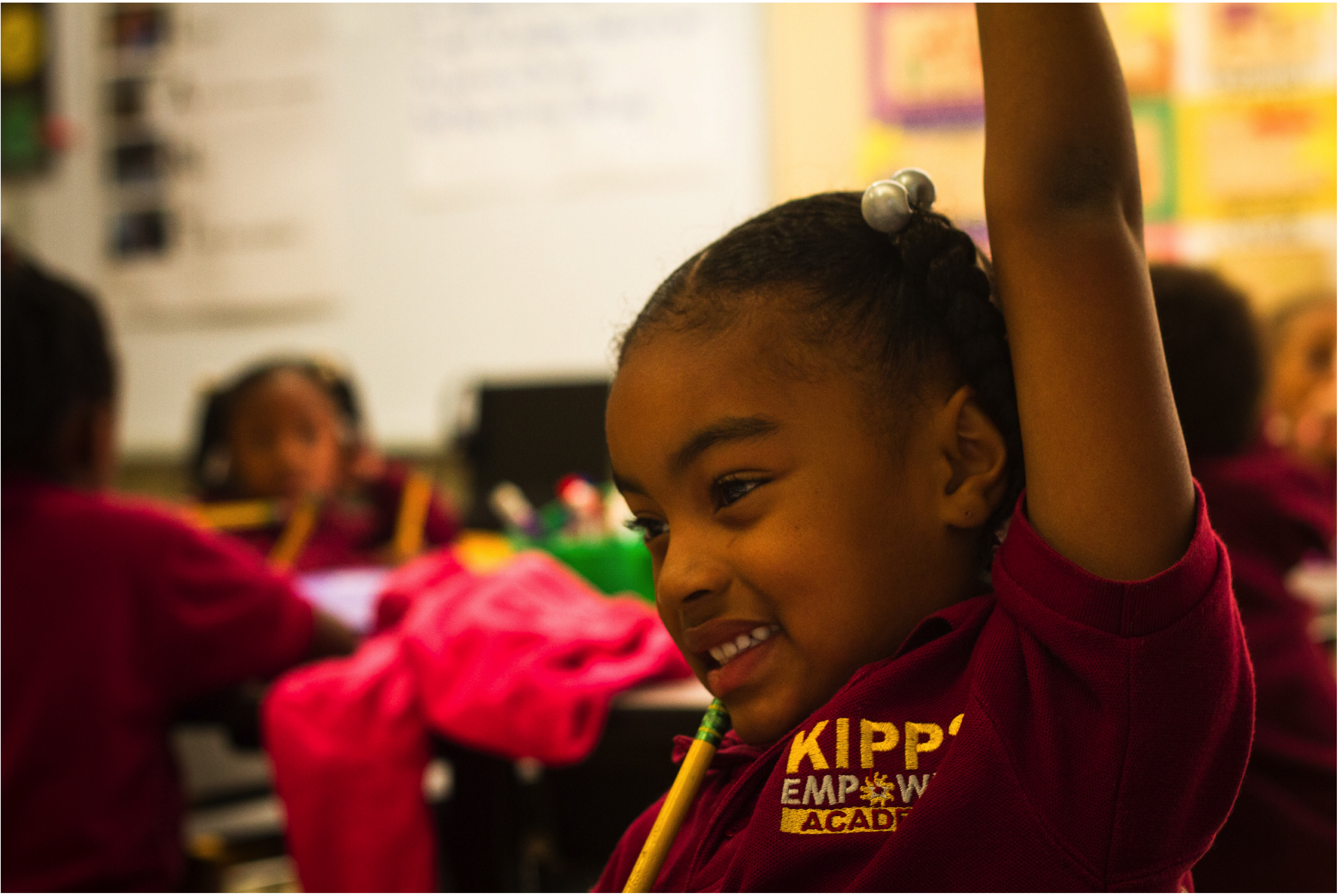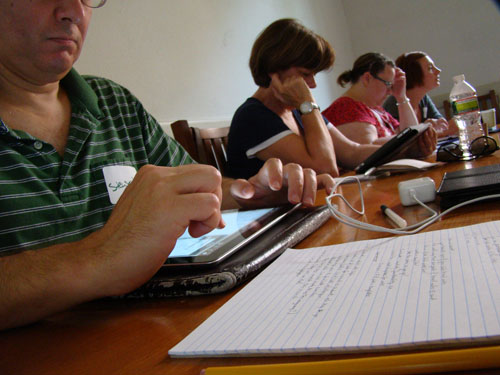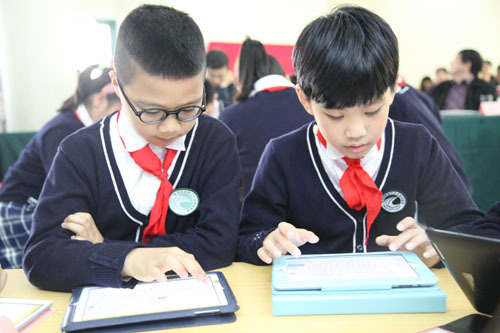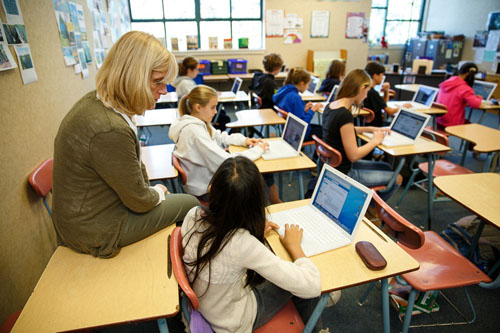Disrupt and Conquer! Até onde a tecnologia pode ir para garantir que nenhuma criança fica para trás na escola? Na corrida da América para eliminar as lacunas realização nacionais e internacionais, quando vai misturado modelos de aprendizagem ser eficaz o suficiente para perturbar o sistema de sala de aula convencional existente?
Em 2008, Michael Horn and Clayton M. Christensen co-authored the book Perturbar Classe: Como inovação disruptiva vai mudar a maneira do Mundo Aprende (McGraw-Hill). Hoje, as executive director of the Innosight Institute, Horn leads a team that studies the innovative ways technology is already transforming America’s education system into one in which every student, whatever his/her learning needs, can realize his/her full potential. Heather Staker is a senior research fellow for the Education Practice at Innosight Institute and the author of “The rise of K-12 blended learning: Profiles of emerging models.”
I asked Michael and Heather to share their insights on blended learning in this week’s edition of A Pesquisa Global para a Educação.
Heather, can you briefly describe the term “aprendizado mesclado” and the four different types of models that serve as blended learning?
Blended learning is a formal education program that includes two components. The first is online delivery of content and instruction, where the students have at least some control over the time, Lugar, colocar, caminho, and/or pace of their learning. The second is that the students also attend a supervised brick-and-mortar location.
Through our research, we are observing four main models. The Rotation model is any time students rotate on a fixed schedule between online learning and other modalities for any given course. In the Flex model, student schedules are more fluid and content and instruction are delivered primarily by the Internet. The Self-Blend model is any time students take one or more courses entirely online to supplement their traditional courses. The Enriched-Virtual model involves students dividing their time within each course between attending campus and learning remotely online.
Michael, which of the four models do you believe is best?
None of the models is “the best” per se. Neste ponto, different schools will be able to put in place different models depending on their distinct needs and capabilities. Longo prazo, I am most intrigued by the Flex model and believe that a combination of it and the Self-Blend model will likely represent the ideal educational model. The reason is that it most naturally puts students first so that all students can personalize and own their learning, which should mean more motivated students and more effective learning for all. The Flex model also creates natural and potentially rich opportunities for students to interact with other students to engage in challenging projects based on each student’s needs while preserving and potentially strengthening activities such as fitness and the arts.
Can you give me a real life example of the Flex model?
One of the best examples I have seen of the flex model was in Morgan Hill, Califórnia. This is a district south of San Jose where about a third of its students are Hispanic and I believe over a third of its students are on free-and-reduced price lunch. The school is called the Silicon Valley Flex Academy – Grades 6 através 12. As you walk into the school there are a couple of huge open spaces on either side where every student has his/her own office. In this space, each student has his/her own computer. The students are encouraged to decorate their own space with things they like (in the same way an adult might decorate an office at work). There are break out classrooms around the perimeter of the building. Here teachers are getting the data on how the kids are doing. Teachers can pull students into these break-out classrooms in very small groups. The teacher is then able to focus on a student’s individual issues. The teacher’s job is totally different in this arrangement. The fascinating thing was how much ownership the students have over their learning. They all knew exactly what was expected of them the entire year. They knew exactly how they were doing at any point. Their job was to learn the material. If they could get the work done during the school day there was no homework. So it was up to the individual students to make those decisions.
You say “the teacher’s job is totally different in this arrangement.” Were teachers learning on the job? Did you see any challenges in terms of educating teachers to use the Flex model?
The teachers I spoke to explained that they had been trained to do lesson planning, lectures to large groups of students and classroom management — none of which they were now doing. They explained that the adjustment was difficult. Training has not been built into the formal teacher training system for programs like this, and few are really thinking about it at the moment. Agora, the teacher is still doing teaching or tutoring when pulling students out into small groups for project-based work, but instead of this being determined by a pacing guide, this is now being determined by where the students are in their learning. What was so interesting was that in this model, teachers were able to do the tutoring and value enrichment work that teachers really like to do but don’t always get time to do in a classroom. One of the challenges the teachers mentioned was staying on top of scheduling. How do you keep track when you have students at different places in the curriculum? Those were tough decisions for teachers to make and they were, como você diz, aprendizagem no trabalho.
Que comentário você recebeu por parte dos alunos em termos de estar motivado para aprender?
A number of students said to me: “Last night I was so bored. It was a three-day weekend and I decided to jump on my computer and do some math.” So I said, “You decided to jump on during the weekend and do math?” One student explained she thought it was fun to go on and get ahead a little bit. When I asked them if they ever did that in their old school model, they replied, “Not a chance!” Quando os alunos possuem seu aprendizado, they feel responsible for it and motivated to do it. What they also appreciated was that the teacher was no longer there to “punish them” ou “grade them down”. Instead the teacher was there to help them reach their goal. This is much more of an environment built around success and motivation versus failure.
How far can online learning in blended systems go towards leveling the playing field for different types of learners?
No momento, it appears that the sky is the limit but we also don’t fully know. Because online learning allows for modularity, it can in theory customize learning for each student’s individual needs. No entanto, we are just in the early days of leveraging this as well as leveraging the enormous amounts of data we can receive in real-time about how a student is doing, which should allow us to adapt our approaches in exciting ways also in real time for each child. Today we’ve grasped the power of online learning to individualize for students, particularly those struggling ones, along the dimension of pace. But we haven’t come close to grasping the power to vary the paths for students.
Heather, what do you believe is the effectiveness of a blended learning school versus a brick and mortal school and versus a school that uses some tech but is not blended?
By many measures, America’s traditional brick-and-mortar classroom model is failing. O Programa de Avaliação Internacional dos Estudantes (PISA) em 2009 ranked U.S. students as 14th in reading, 25th in math, and 17th in science compared to students in other industrialized countries. Uma das causas deste mau desempenho é que o sistema é inflexível. Os estudantes se movem através níveis escolares em lotes padronizados e currículos monolítico, independentemente de como cada criança aprende melhor. Líderes de escola muitas vezes acho que a tecnologia vai ajudar. Eles acrescentam que bling com lousas eletrônicas, iPads, e planos de aula digitais, mas nenhum destes no seu próprio transforma a estrutura fábrica. A atração de misturar aprendizagem on-line para as escolas é que a aprendizagem on-line permite modularidade. It can customize around the learning pathway each student follows, who teaches them, and how fast they master each concept. Several schools are already delivering highly customized blended-learning environments, and the results are promising.
Michael, what challenges do you see with blended learning systems?
I think one challenge is executing it well. I think the changing role of the teacher is profoundly challenging. It is unfair that a huge percentage of what teachers have been taught is irrelevant in this learning environment. The beauty of this system is that computers are able to do what computers do well. Humans are freed up to do what humans do best.
I also think the assessment system that we have in place in schools is a problem for this learning system going forward. Assessment needs to be based on where each individual child started and then grew to and finally ended up in a particular year, versus a snapshot once a year view of an entire school.
For more information on the Innosight Institute: http://www.innosightinstitute.org/

Photos courtesy of Silicon Valley Flex Academy and Stern + Associados.
Na busca Global para a Educação, se juntar a mim e líderes de renome mundial, incluindo Sir Michael Barber (Reino Unido), Dr. Michael Bloco (US), Dr. Leon Botstein (US), Professor Clay Christensen (US), Dr. Linda, Darling-Hammond (US), Dr. Madhav Chavan (Índia), Professor Michael Fullan (Canadá), Professor Howard Gardner (US), Professor Yvonne Hellman (Holanda), Professor Kristin Helstad (Noruega), Jean Hendrickson (US), Professor Rose Hipkins (Nova Zelândia), Professor Cornelia Hoogland (Canadá), Senhora. Chantal Kaufmann (Bélgica), Dr. Eija Kauppinen (Finlândia), Secretário de Estado Tapio Kosunen (Finlândia), Professor Dominique Lafontaine (Bélgica), Professor Hugh Lauder (Reino Unido), Professor Ben Levin (Canadá), Professor Barry McGaw (Austrália), Shiv Nadar (Índia), Professor R. Natarajan (Índia), Dr. PAK NG (Cingapura), Dr. Denise Papa (US), Sridhar Rajagopalan (Índia), Dr. Diane Ravitch (US), Sir Ken Robinson (Reino Unido), Professor Pasi Sahlberg (Finlândia), Andreas Schleicher (PISA, OCDE), Dr. Anthony Seldon (Reino Unido), Dr. David Shaffer (US), Dr. Kirsten Immersive Are (Noruega), Chanceler Stephen Spahn (US), Yves Theze (Francês Lycee EUA), Professor Charles Ungerleider (Canadá), Professor Tony Wagner (US), Sir David Watson (Reino Unido), Professor Dylan Wiliam (Reino Unido), Dr. Mark Wormald (Reino Unido), Professor Theo Wubbels (Holanda), Professor Michael Young (Reino Unido), e Professor Minxuan Zhang (China) como eles exploram as grandes questões da educação imagem que todas as nações enfrentam hoje. A Pesquisa Global para Educação Comunitária Página
C. M. Rubin é o autor de duas séries on-line lido pelo qual ela recebeu uma 2011 Upton Sinclair prêmio, “A Pesquisa Global para a Educação” e “Como vamos Leia?” Ela também é autora de três livros mais vendidos, Incluindo The Real Alice no País das Maravilhas.






Comentários Recentes